We may receive a commission when you use our affiliate links. However, this does not impact our recommendations.
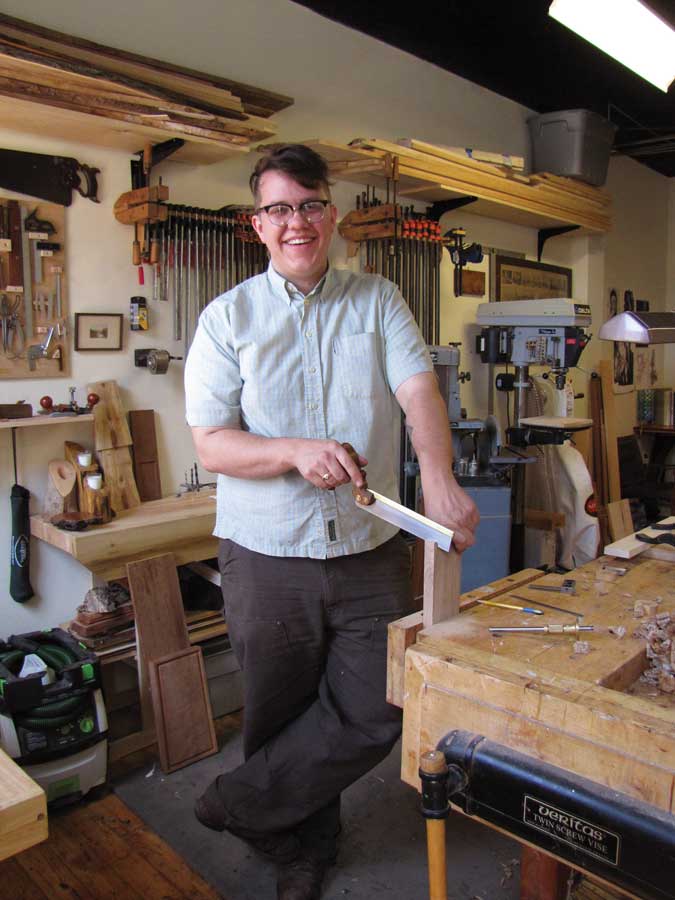 I’m delighted to announce that Brendan Bernhardt Gaffney (whom you may know from his ancient rules, sector, calipers and other work at burnHeart) joins the Popular Woodworking team in July as managing editor. He’ll not only be handling the day to day business of running the magazine, but bringing to the job his woodworking and toolmaking experience, and impressive computer skills – not to mention unbounded creativity.
I’m delighted to announce that Brendan Bernhardt Gaffney (whom you may know from his ancient rules, sector, calipers and other work at burnHeart) joins the Popular Woodworking team in July as managing editor. He’ll not only be handling the day to day business of running the magazine, but bringing to the job his woodworking and toolmaking experience, and impressive computer skills – not to mention unbounded creativity.
Brendan’s first days as part of the team will be at the Lie-Nielsen open house July 7-8 in Warren, Maine (where I’ll be, too), then he and his partner, Josselyn, are moving to the area. We seduced them over a weekend visit that involved a lot of fun looking at neighborhoods in Cincinnati and Northern Kentucky, visiting a few hospitals (Josselyn is a recent nursing school graduate), and eating far too much (special thanks to Christopher Schwarz and Lucy May for the delicious Saturday night feast and excellent company).
And in on the off chance you don’t know Brendan and his work, read the article below – he was featured in our Great Woodshops series in the November 2016 issue, in an article by Cathrine O. Frank.
And please join me in welcoming him to Popular Woodworking.
From Redwoods to Red Brick
Brendan Bernhardt Gaffney: Ruler of Ancient Rules
At burnHeart, in a converted textile mill on the banks of Maine’s Saco River, Brendan Bernhardt Gaffney rifles through a box of stainless steel “lady legs” (a.k.a. “Dancing Master” calipers) that were laser cut in a shop up the road. Overhead, lengths of Maine maple share space with other local woods that will become the Krenov-style cabinet he’s finally begun or the standard edition of his sought-after line of rules.
“To have a business where I can go to the guy who cut down the tree, and then speak individually with every person buying them and make the thing myself is such a nice, complete picture of making things,” he says. If it’s a picture that taps into the vogue for holistic approaches to production, independent business models and, of course, craft, it also marks the junction of Gaffney’s diverse experiences.

Well-read. “I have as many books about trees and forestry as I do about woodworking because it’s such a cool part of the process.”
The DIY Student
Making things is second nature to Gaffney, whose family includes an artist, poet, weaver and woodworker. “We’ve had a woodshop my whole life,” he says. This thanks to his dad who, before finding a career in advertising, worked “all sorts of funny jobs” across Staten Island, including a stint in a puppet shop. “I grew up around people making things,” Gaffney says. “That was always going to be some angle of what I was interested in doing.”
After high school, Gaffney attended Skidmore College where, true to form, he designed his own major in “Sound,” bringing art, physics, neuroscience and computer science to the study of music. In his master’s work in computer science at the University of California, San Diego, he worked on programming and designing both physical and digital musical instruments. “I’ve always had this idea that whatever it is I’m going to be studying, I want to be making it,” he says. Opportunities were not lacking: He built analog synthesizers and worked as the “wood guy” for the San Diego Fablab, a community fabrication space.
But building prototypes for other entrepreneurs left him wondering, “When do I get to make things?”
Still in California, he applied to College of the Redwoods (CR) and spent a year making his tools, working on that “fair curve” and confirming “wood was my medium.” He returned to New York and spent four months at the manufacturer and retail store Tools for Working Wood where, as a woodworker among machinists, he talked shop with customers and gained experience in marketing and sales along the way.
Equal parts wanderlust and desire for his own shop pushed Gaffney to Maine, where he worked for a violin and guitar maker. Working with a luthier offered “the wonderful marriage of woodworking and music” and, even more, the “small, delicate, nice work” he was looking for.
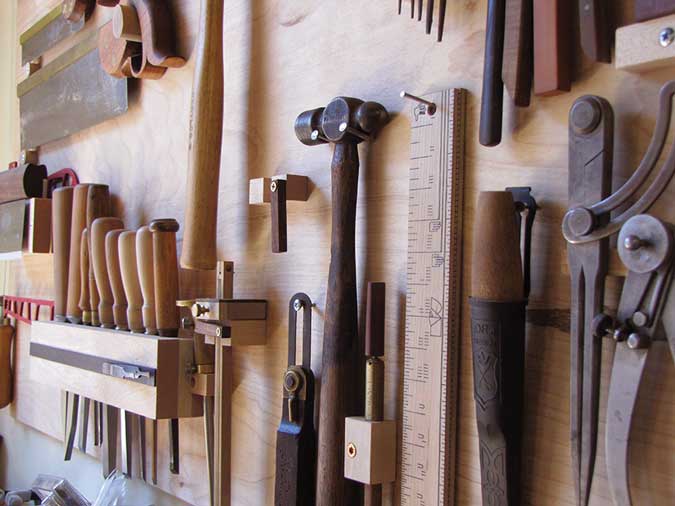
Hybrid approach. Though 90 percent of Gaffney’s work is with hand tools, he relies on powered machinery for roughing out and CNC for etching.
A Series of Good Ideas
Gaffney’s interest in making unique woodworking tools dates to his time at CR. “I was in love with this,” he says of making those first planes. “As much as making the cabinets was exciting, making the tools to make the cabinets was really fulfilling. And then using the tools you’ve made – it’s such an awesome, holistic thing to take that full journey.”
But as a business venture, tool-making was something of a pipe dream. His first line of “period correct antique rules” – the Japanese kanejaku is nothing if not “small” and “delicate” – began as “a fun idea” to share on social media, but when the first run sold out in a half-hour, Gaffney realized, “This is not necessarily a one-time, funny, art design project.”
Joining the kanejaku are an Egyptian cubit and span and a Roman cubitus. Based on well-researched, well-established sets of measurements, these “rulers of the ancient world” (the pun is intentional) offer a unique point of access to their respective cultures.
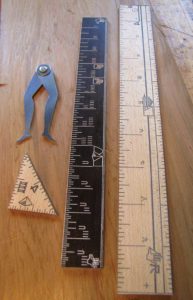
Research everything. The Egyptian measurement is based on a cubit rod taken from an architect’s tomb. “Someone can hold my ruler up to the ancient artifact and say, ‘Oh yeah, it’s the same.’”
Four thousand years ago, Egyptian builders would have used tools almost identical to ones used today, “other than the measurement system,” Gaffney explains, which goes some way toward explaining the rulers’ popularity. There’s an even split between buyers excited about having “a tangible object representing a system that’s 4,000 years old” and others who need it because they actually want to make a Roman bench.
Plus, they’re nice to look at and touch. Each is handplaned, hand-rubbed with India ink and French polished. The standard editions are made of local rock maple, and there is a limited edition in period correct woods: African blackwood (a form of rosewood the Egyptians took in “tribute”) for the cubit and span, Japanese cedar for the shaku (another name for the kanejaku) and European sycamore for the Roman cubitus.
Building on the rules’ success, Gaffney looked to Victorian-era tool design and the practice among woodworkers and machinists of ornamenting their tools. Enter the Dancing Master calipers. “Instead of putting up Playboys in the shop,” he explains, making little leg calipers may have been the most risqué thing they could do. Like the handwork that goes into the rules, he drills, smooths, polishes and rivets each set by hand.
Design, Craft & Mechanical Reproduction
Asked about his favorite tool, Gaffney answers immediately: handplane. Planing is, he says, “Such a rewarding process versus sanding,” adding that 90 percent of what he does – from making tools to building furniture – is handwork. But with multiple runs to fabricate, Gaffney is quick to point out how machines factor into production and design: band saw for ripping and rough dimensions, CNC for etching the rules and so on.
From his undergraduate major to his professional logo, Gaffney’s love for design comes through. Turning an idea into a physical product is, quite simply, “so much fun.” If the experience of making a cabinet has a downside for Gaffney, it’s only that “you’re realizing it once.”
This is where iterative design comes in. By mixing modern tooling with hand processes, he gets to “scratch the itch of making a cabinet.” “The rulers are handplaned and I’m shooting the edges” – work he’d be doing on a cabinet, he explains – “but then I’m also etching them. I’m drawing on the computer and drawing by hand.” With between 20 and 40 rules in each batch (and he’s done seven so far), he gets to rethink and redesign, make a new tool to improve the process and ultimately improve the product. Idea, Produce, Sell, Reiterate, Redesign.
“It’s part of that total process.”
A Modern Maker
Using a plane he made himself, Gaffney smooths an Egyptian ruler. “As much as having the Egyptian ruler made in African blackwood tells a story about that culture, that ruler and that system, having the other rulers made in maple tells a story about me, my process and where I am,” he says.
Having recently relocated to the red brick North Dam Mill, what’s ahead for burnHeart? A Japanese elm dovetailed cabinet, for one. Now that he has his own shop, he’s got the space to do it. He will continue his line of calipers, niche rules and custom rules (personal cubit, anyone?) and is also in conversations with furniture designers about developing tools specific to their projects – using André Roubo’s copperplates, for example.
Taking furniture commissions, designing products for museum exhibitions, even experimenting with a line of tool lubricants using wood-derived oils – Gaffney loves the flexibility that independence brings but eyes the balance between “the romantic view of being a woodworker in a shop and the practicality of being self-employed.” A regular process in itself, tool making is both “a nice way to support my more speculative projects” and integral to a larger search for sustainability. PWM
Cathrine lives in South Portland, Maine, where she’s rehabbing an early 20th-century Cape Cod (it’s full of antiques she’s repaired and refinished).
Here are some supplies and tools we find essential in our everyday work around the shop. We may receive a commission from sales referred by our links; however, we have carefully selected these products for their usefulness and quality.



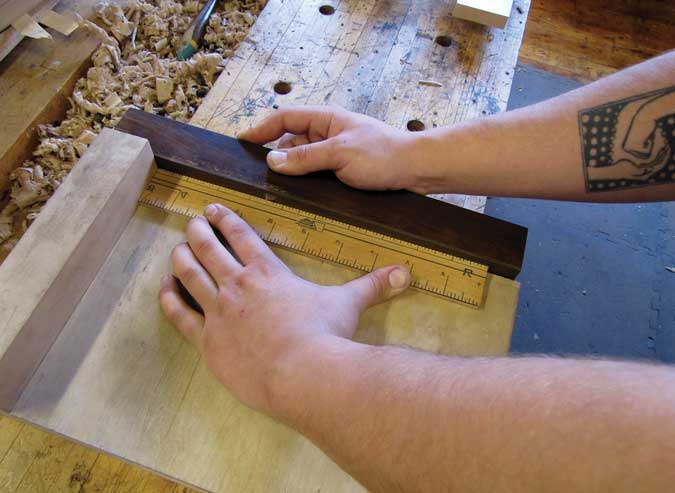





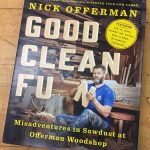

I am sure he will be a great addition to the PWW team, but it is a loss from the Tool Maker perspective. Hopefully he will find some time to do both, or perhaps train someone to continue production of his tools.
Welcome Brendan. And have fun in Cincinnati – it’s a great city.